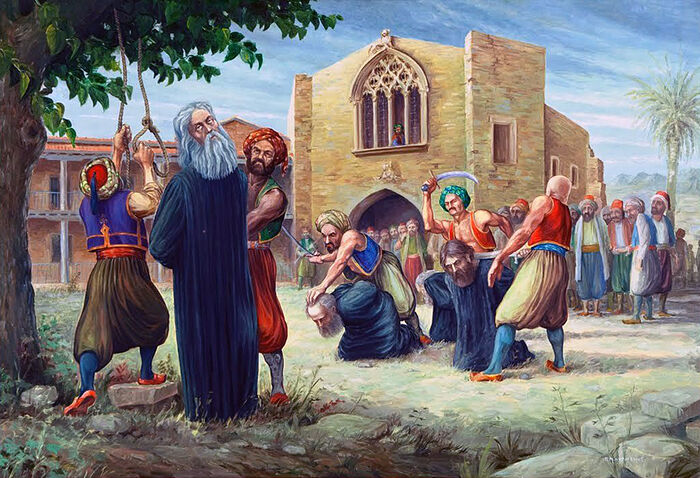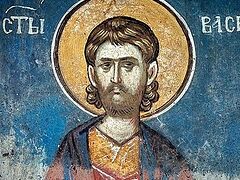On the third Sunday after Pentecost, the Church honors the memory of the Martyrs of the Turkish Yoke.The following article is condensed from a lecture delivered at the St. Herman Summer Pilgrimage, August, 1982, and first printed in Orthodox America.
On May 29, 1453, the troops of the Moslem leader, Mohammed II took the great city of Constantinople. For more than 1000 years Orthodox Christians had assumed that the Byzantine Christian Empire would stand until the Second Coming of Christ. They had always called their city the “God-protected City,” and indeed, until now it had been protected by Heaven. But when their Emperor, Constantine XI, fell in battle, the holy city of Byzantium became the capital of a new empire, the Ottoman Empire, ruled by a pagan people, enemies of Christ and Christianity, the Moslems. It was a dark, dark time for Orthodox Christians in that part of the world.
In their violent hatred of Christianity, the Moslem Turks embarked on a course of persecution designed to effectively muzzle the flock of Christ. Their strategy was no less cruel than that of atheist communists in the Soviet Union; the parallels are striking. Most of the churches of Constantinople (whose name was changed to Istanbul, just as years later Petersburg was changed to Leningrad) were converted to mosques. Their movable icons were destroyed and whole walls of inspiring and radiantly beautiful mosaics were covered with paint or plaster. Crosses were torn off domes and broken off the roofs of churches. The Moslems guaranteed Christians a definite place in Turkish society; but it was a place of guaranteed inferiority. Orthodox Christians were required to pay an annual head tax, like cattle. To the Turks they were unbelievers, and they had absolutely no rights of citizenship. They even had to wear distinctive dress. They could not marry Moslems, nor could they engage in missionary work of any kind; in fact, it was a crime, usually punishable by death, to convert a Moslem to the Christian Faith.
As if these measures were not enough, the Moslems actively undertook to control the Church itself. The Sultan ironically considered himself the “protector” of Orthodoxy, supposedly guaranteeing the existence of the Church, but actually keeping it in the vise of a terrible stranglehold. Under this system each Patriarch had to pay a stiff fee to the Sultan before he could be enthroned. Unable to raise the funds himself, the Patriarch was forced to exact a fee from each new bishop before installing him in his diocese, and this burden was eventually placed on the flocks. Taking advantage of this financially lucrative situation, the Turks forced re-elections of the Patriarch with undue rapidity. The majority of the Sultans themselves were sick, demon-ridden men, whose irrational rule and unbridled power only heightened the already demoralizing effect of Turkish rule on the Church. It is not without reason that an Englishman living in Istanbul in the seventeenth century wrote these words: “Every good Christian ought with sadness to consider and with compassion to behold this once glorious Church tearing and rending out her bowels and giving them as food to vultures and ravens.
The aim of Orthodoxy in the Ottoman Empire became, simply, one of survival. Little could they know, in 1453, that the heavy sword of Islam would weigh upon them not for a generation or two, but for five hundred years, five long centuries of darkness and difficulty. But even under such ruinous circumstances, God did not allow the light of Christianity to be extinguished. It was kept alive through the courageous confession of the New Martyrs of the Turkish Yoke.
When speaking of New Martyrs today, one generally thinks of the recently glorified New Martyrs of Russia. But until just last year, the “New Martyrs” listed in the Orthodox calendar of saints referred to those men and women who suffered for the faith under the Turkish Yoke. Their lives are not very well known, and yet they are a rich catalogue of the diversity and generosity of the Holy Spirit acting in the lives of Orthodox believers in time of oppression and persecution. The following examples illustrate the image often used in their Lives which describes them “laboring like diligent bees, gathering the honey of virtue” as they moved through life towards martyrdom.
Guard the deposit; keep safe what has been entrusted to you (I Tim. 6:20).
St. Cyprian the New, for instance, was a pious monk from Mount Athos. After fortifying himself with Holy Communion, he went forth and found a Pasha (the ruler of a province). Straight way he witnessed to him that Mohammed was a false prophet and the enemy of God. The Pasha only laughed, thinking he was crazy; he ordered his guards to beat him and cast him out, which they did. St. Cyprian then went to Constantinople, to the Grand Vizier whose position was like that of a prime minister. There he attempted to witness to the Grand Vizier by sending him a written message about the Gospel of salvation. The Vizier thought the saint must be drunk, or mad. But when at last he realized that the saint was quite sober and quite sane, he ordered that he be beheaded and, as his Life says, as he was being led to the place of execution, “his face shone with joy; it was as though he hurried not to execution, but to a wedding banquet.”
St. Timothy of Esphigmenou is an example of a Christian who betrayed Christ and then returned to suffer martyrdom for his Lord. He was married, but his beautiful wife was abducted by a Moslem who added her to his harem after forcibly converting her to Islam. In order to get his wife back through the process of Islamic law, St. Timothy himself converted to Islam. His wife was indeed returned and they both secretly repented of having converted to Islam and returned to Christianity. Finally, his wife withdrew to a convent and he to Mount Athos, where he became a monk and prepared for the day when he could descend back into the Turkish world, there to “witness for Christ and accept martyrdom”, which in fact he eventually did.
Sometimes the family of a martyr would beg him to embrace Islam rather than die. In the life of St. Zlata, a pious virgin-martyr of the thirteenth century, for example, the parents and sisters of the saint implored her to convert to Islam, saying, “O sweetest daughter, have pity on yourself and on us your parents and your sisters… Deny Christ just for the sake of appearances.” But she turned and said to them? “You who incite me to deny Christ, the true God, are no longer my parents and sisters… But in your place, I have my Lord Jesus Christ as a father, my Lady the Theotokos as a mother, and the saints as my brothers and sisters.” She suffered a particularly horrible form of torture and martyrdom, including thrusting a red-hot skewer through one ear and out the other, so that smoke came forth from her nose and mouth. The writer of her life tells us that her sufferings were so terrible “that even the most stout-hearted of men would be humbled.” This martyr, he says, “now dances and rejoices together with the prudent and prize-winning virgins in the heavenly bridal chambers, and stands at the right hand of her Bridegroom, Christ.”
Another striking example of faithfulness to Christ and His Church is found in the Life of Martyred Monk James and his disciples. This Saint led a very pure life and was often vouchsafed to see angels during the Divine Liturgy. One day, while a guest in the home of a wealthy Turk, St. James declined the meat given at a banquet because it was the Apostles’ Fast. This identified him immediately as a Christian. For such a holy one as this, the Moslems devised a particularly painful method of torture and death, which included wrapping bands of cloth around his head and twisting them gradually, crushing the skull
There were many rewards given to those Christians who would convert to the Moslem religion. Sometimes these enticements worked and Orthodox believers gave up the struggle for the true Faith. St. John the Bulgarian was a young boy when he fell into the company of some Moslem youths and was led by peer pressure to renounce Christ and follow Mohammed. It was not long before he came to his senses and, overwhelmed with grief at having renounced Christ, he fled to Mt. Athos and gave himself up to a life of repentance. His conscience, however, would give him no rest until finally he set out for Constantinople in order to preach the Gospel. Dressing as a Turk—something forbidden to Christians—so as not to be detected, he entered a great mosque. There, in front of everyone, he made the sign of the cross and began to pray, witnessing to all that he had been a Christian and had fallen away, but that he had now been delivered from the error of Mohammed. Concluding with the ringing declaration, “Without Jesus Christ there is no salvation!” St. John was dragged out into the courtyard of the mosque and beheaded.
While many other Christians lived in daily fear and trembling, these noble warriors of Christ marched forth directly into the enemy’s camp in order to boldly plant the cross of Christ like a battle banner. Penetrated by the very essence of Christianity, Christ Himself; they were able not only to endure the most frightful tortures, but also to be victorious. The victory of martyrs, however, is understood only from an otherworldly perspective, for they had deep in their hearts the words of Scripture:
What will it profit a man if he win the whole world and lose his sou1? What can a man give in exchange for his soul?
To paraphrase the closing paragraph from the life of yet another confessor of the Turkish Yoke:
Where are those Moslems who once saddened and despised the New Martyrs? Where are the m i g h t y of the earth? Where is the Ottoman lord? Where the fearsome guards and Tartars who bound them and beat them and martyred them? Where are their pampered bodies? O! They are dispelled as a morning mist. The tombstone of forgetfulness has covered them. And in Jerusalem on high, in the dwelling where are found the blessed souls of the saints who lived in privation in this world so that they might pass through the narrow and afflicted w a y that leadeth unto life, there rejoices also with them the spirits of these much-suffering martyrs whom we remember today. They reposed in the Lord and received the reward of the labors and toils and pains which they endured for Christ, Whom they loved more than all the fleeting things of this world. And now, wearing crowns in heaven, they rejoice with the choirs of the saints and behold in glory the Prize-bestower, our Lord Jesus Christ Himself. To Him be glory and dominion and worship unto the unending ages. Amen.





